Ecommerce is quietly and conveniently taking over our lives. According to Jeff Bezos, Amazon has over 100 million Amazon Prime members. Free shipping is the norm. Two-day shipping is becoming one-day or two-hour shipping.
If you want to start your ecommerce store, choosing the best ecommerce platforms can be tough – there are over 477 different options.
I want to make this decision easier by showcasing the best ecommerce software so you can find the right solution for your online store. Let’s face it – with so many options on the market, there will only be a few left standing in the end, so you want to make sure you pick the winner.
Why should you trust these reviews?
I have over 10 years of ecommerce experience:
- I’ve managed marketing teams for ecommerce brands making over $100 million/year.
- In a previous role, I was in warehouses and managed wholesale shipments.
- I’ve managed 8-figure/year ecommerce marketing budgets.
- I’ve worked for SaaS companies in the ecommerce space.
- And I’ve launched online stores on almost every platform.
These reviews rank based on price, reliability, technical support, features, scalability, product options, shipping, fulfillment, control panel experience, and more.
We’ll also compare and review things like:
- The best choices for small businesses.
- The top cheap, free and open-source options.
- Enterprise solutions for large brands.
Let’s get started.
What Are the Best Ecommerce Platforms?
Ecommerce platforms are robust, full-featured software tools to sell products online. When choosing from the best options, there are many considerations, and each ecommerce website builder provides different features.
For example, your needs will be different if you’re selling three products vs. 100. Or if you want to do dropshipping rather than your own shipping and fulfillment.
Ultimately, ecommerce software should let you add your products quickly, offer coupons and discounts, and automatically track inventory. They should also help manage shipping and fulfillment so that you can focus on running your business.
Here are my picks for the best ecommerce platforms to try this year:
1. Wix.
Best Ecommerce Platform for Small Business and Hundreds of Themes ($23/month).
Wix is a fast-growing website builder that allows users to upgrade to full ecommerce functionality for $20 per month. They boast hundreds of designer-made templates, promotions and gift cards, beautiful product galleries, and easy order management and shipping.
They automatically optimize your online store on mobile, including iPhones and Android devices (Apple and Google). You can also customize the look of your mobile ecommerce site with their online store builder tool. You don’t need to dive into HTML or CSS to create a stunning website with Wix.
They have an excellent array of product galleries to layout your products in a beautiful (and conversion-optimized) way.
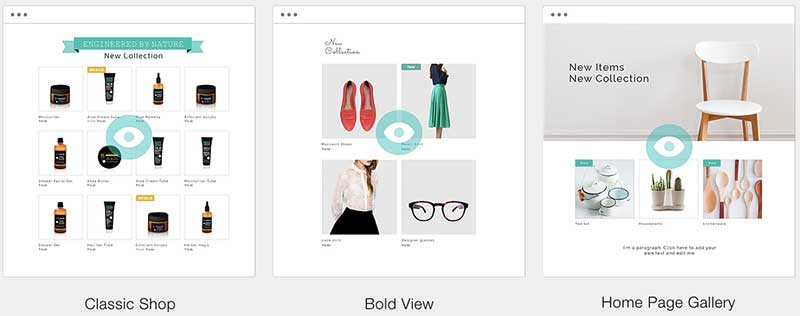
These product galleries layout great on mobile devices too and adapt in a stacked format.
Wix is also known as one of the easiest tools to use in both the website builder and ecommerce space.
There are literally only seven steps needed to build your online store:
- Log in to your account or sign up for free.
- Pick a template from the Online Store category.
- Edit the text and add your business name.
- Click “My Store” & “Manage Your Store”.
- Add products to your store.
- Select “Business Setup” to add Payments, Shipping & Store Settings.
- Publish your site & connect to your own domain.
Finally, Wix offers a secure checkout, 24/7 customer support, multiple payment options and solutions, global tax and shipping, and coupons and discounts to help you sell more.
Try Wix for free and start selling your products online.
2. BigCommerce.
Best Ecommerce Platform for Large Businesses Built to Scale ($29.95/mo).
BigCommerce is my #2 ecommerce platform recommendation. They have best-in-class SEO features, 40+ payment gateways, advanced product options, 24/7 support, and can scale with your ecommerce business up to over $100 million per year.
Here’s what typically happens.
A small business owner decides to get into ecommerce and chooses a platform like Shopify because of their name recognition. After 6-12 months, they start growing sales and paying extra for apps and add-ons to help their ecommerce business grow.
After some time, they hit a growth ceiling. These users may realize they are paying hundreds of dollars every month for apps, their SEO is lacking, or they’re outgrowing their platform.
Enter BigCommerce:
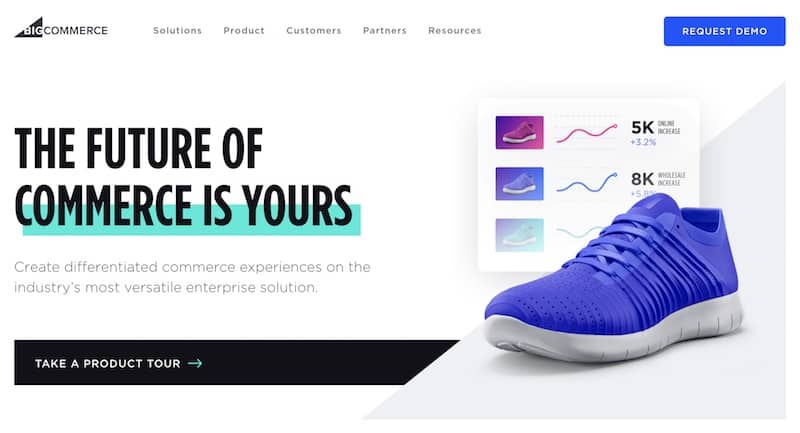
They are the most open SaaS ecommerce platform on the market – open APIs, zero transaction fees, and an open partner ecosystem.
BigCommerce has two product offerings: BigCommerce (their enterprise offering) and BigCommerce Essentials (built for small businesses). Both are built to scale with your growth.
On the one hand, they are an accessible platform for small business owners because of their features and built-in functionality. However, there is a slightly higher learning curve than an easier tool like Wix.
They’re also perfect for enterprise brands looking to leave expensive on-premise solutions like Magento and move to software as a service (SaaS). Brands like Ford, Toyota, Skullcandy, and others in the Fortune 1000 use BigCommerce and can easily bring in over $100 million in annual sales without hiccups.
In December 2018, they launched BigCommerce for WordPress, a “headless commerce” product, allowing users to manage their front end content on WordPress and their backend ecommerce with BigCommerce.
This use of APIs allows for faster WordPress site speed than you find with other WordPress ecommerce options like WooCommerce, which installs multiple plugins to work and hinders performance.
Their plans start at $29.95/month, and with that, you get a branded online store and domain name with the ability to sell on Amazon, eBay, and social media like Facebook, Instagram, and Pinterest.
They have a simple user interface to build your online store, including sections for your orders, products, marketing, analytics, taxes, and your storefront:
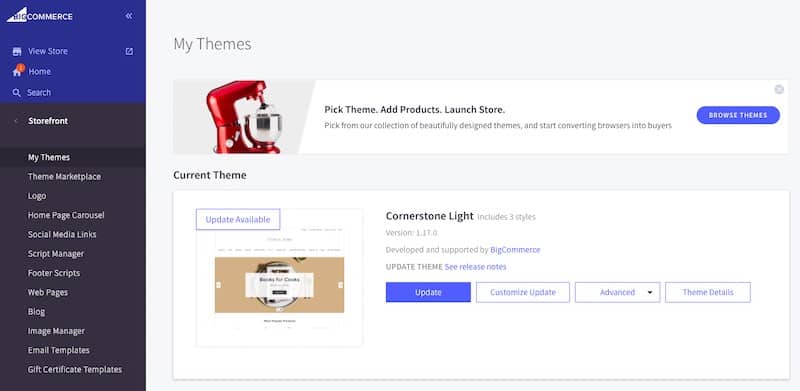
With the newly launched BigCommerce Shipping features, you get discounted carrier rates and gain the ability to print shipping labels and manage fulfillment right in your dashboard.
Their themes are fully responsive and optimized with conversion rates in mind. They also offer free SSL certificates, have a clear pricing structure, and again – zero transaction fees.
BigCommerce receives my highest recommendation for medium to large businesses and you can get started with a 15-day free trial.
3. Shopify.
Great Ecommerce Software for Dropshipping ($29/month).
Shopify is an ecommerce powerhouse, hosting over 400,000 merchants worldwide. When you think of ecommerce, your mind might go right to Shopify. They’re a Canadian company that launched in 2004 and quickly became one of the fastest-growing SaaS companies in North America.
Dissatisfied by existing mobile apps and ecommerce products on the market, Tobias Lütke, Daniel Weinand, and Scott Lake built their open-source web application with Ruby on Rails and launched after two months.
That program became Shopify.
One reason Shopify gained massive brand awareness was by appealing to the audience of “dreamers” – new users who want to strike it rich in ecommerce.
With their integrations, even the most inexperienced users can set up a dropshipping store with relative ease. I tested it out. After picking my inventory, I integrated a few dropshipping suppliers with Shopify and test-launched a store.
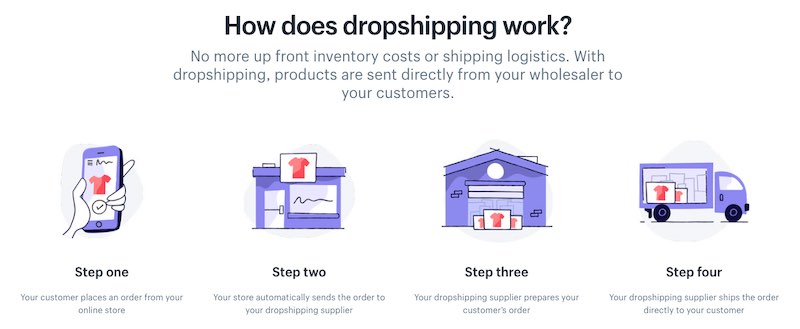
It was easy to design a cool-looking website and add products. But just because you have an online store doesn’t mean it is a successful one – you need to market your business.
A few drawbacks to Shopify are their SEO rules. Your URL structure locks into their format. For example, instead of category pages located at campingsite.com/tents, Shopify forces you to use their format of campingsite.com/collections/tents. This structure is not ideal for search rankings, especially considering “category” is a higher-level subfolder than the more critical keyword “tents.”
Second, they have fewer product options than BigCommerce. If you are selling t-shirts, for example, and have different colors, materials, and sizes, your SKUs add up quickly. Shopify is limited to only 100 product variants – not enough if you have a lot of different product combinations.
Limitations aside, Shopify is a reliable ecommerce platform that works well for small businesses.
Shopify has three plans ranging from $29 to $299. Additionally, its enterprise Shopify Plus platform offers its own custom pricing.
All plans include unlimited products, free SSL, discount codes, inventory management, multilingual support, easy buy buttons, abandoned cart recovery, marketing features, and 24/7 support.
To test them out for yourself, they offer a 14-day free trial.
You can also read my full Shopify review or my article on a full comparison of BigCommerce vs. Shopify.
4. Square Online.
Best For Retailers and Local Businesses Looking to Move Online (Free – $72/month)
Square, the popular POS system, launched Square Online as an ecommerce offering to help retailers move their businesses online.

It’s a strong standalone ecommerce platform but also adds great options for local businesses, like curbside pickup and local delivery.
Here’s how you can get started with Square Online:
- Create your website using their pre-made templates, add pages with page editors, and add your store details.
- Add products to your store.
- Launch your store for free (only pay 2.9% + $0.30 per transaction). Or you can move to a paid plan for more advanced features.
It’s a very easy setup and a flexible option made for small businesses looking to quickly and easily move online.
You can sell directly from your Instagram feed and then expand to a full ecommerce website when you’re ready.
Another strong feature is their secure online payments and ability for customers to pay via Apple Pay and Google Pay.
Square Online also has a number of unique features for small business websites:
- Online food ordering for restaurant websites.
- Tools for online and in-person retail.
- Online bookings through Square appointments.
- The ability to accept donations for nonprofit websites.
Square Online Pricing
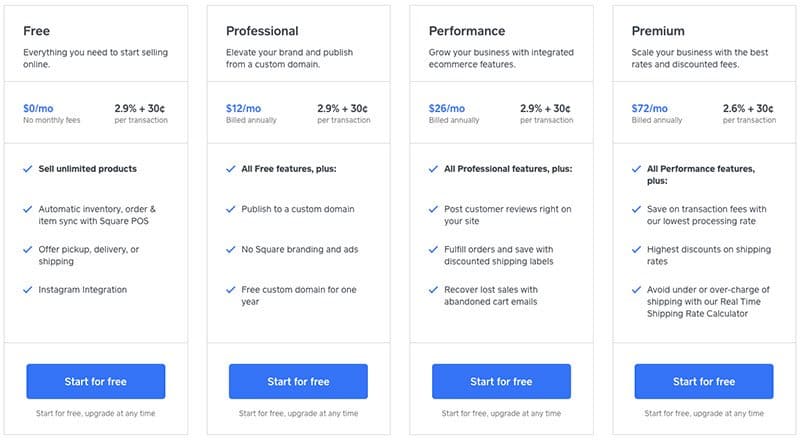
Square Online has a completely free plan, which includes unlimited products, in-house and on-demand delivery, gift cards and coupons, SEO tools, an SSL certificate, integration with Instagram, inventory sync with Square POS, and more.
You only pay the 2.9% + $0.30 transaction fee and $0.50 per delivery. One drawback of this plan is that you don’t get to use your own domain name.
If you’d like to upgrade to one of their paid plans, you get extra features:
- Professional ($12/month): Custom domain name (free for one year) and no Square branding.
- Performance ($26/month): Adds abandoned cart emails, on-site customer reviews, and discounted shipping labels.
- Premium ($72/month): Lower transaction fees, highest shipping discounts, and a real-time shipping rate calculator.
This is nice because you can scale your plan as your online business grows. If you’re just starting to sell online, I recommend you get started with their Professional Plan and then scale up to the higher-tier plans as your orders increase.
Overall, Square Online is a great choice if you’re a traditional retailer or local business looking to move online.
5. Zyro.
New Ecommerce Platform Best for Multi-Channel Sales ($14.99/month).
Zyro is a popular website builder that just released its long-awaited Zyro ecommerce platform.
Launched in early 2020, their new online store builder takes all of the great features they’ve developed over the years as a website builder and adds a full suite of ecommerce features.
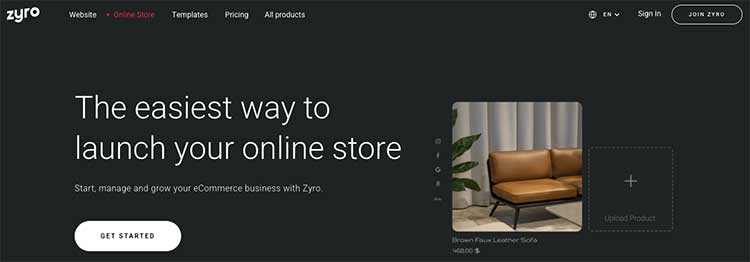
This platform excels in a few key areas. First, they provide their merchants the ability to sell products across multiple channels, including Amazon, Facebook, and Instagram.
Second, it’s simple to use. Much like Shopify, they say that you can start selling in under an hour. And it’s true. With their drag and drop website capabilities and quick set up guide, it’s an easy code-free process.
Zyro provides everything you need to run an online store, including:
- Order and inventory management
- 50+ payment options and commission-free sales
- Shipping and tax management
- Discount codes and gift cards
- Email messages and notifications
- Multiple storefronts: online store, plus Amazon, Facebook, and Instagram
- Free hosting
There are a few small drawbacks though.
Since they are such a new platform, advanced features are still being developed and may be absent. Zyro currently has 68 ecommerce themes to choose from. I also spoke with their team and they promise to have over 150 new themes soon. Not bad for a new platform!
One important note is that any Zyro template can be used for an online store – you just have to go to their elements section in the editor and “add e-shop functionality.”
Let’s move onto pricing.
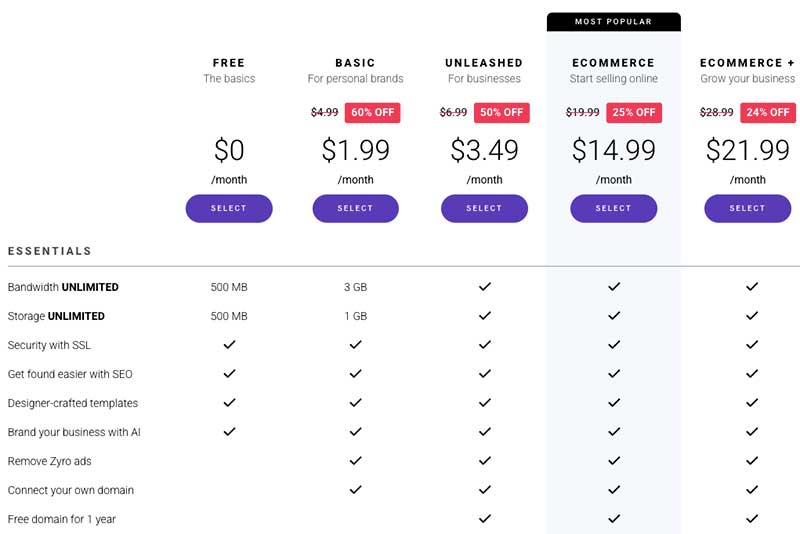
In addition to their free plan, Zyro added two new ecommerce plans: Ecommerce (most popular) and Ecommerce +.
- Their Ecommerce plan is $14.99/month (or $8.99/month for a 3-year term).
- The Ecommerce + plan is $21.99/month (or $10.99/month for a 3-year term). This plan adds features like abandoned cart recovery, multi-channel sales, and multi-lingual stores.
Overall, if you want a simple-to-use, multi-channel ecommerce platform, give Zyro a try. You can start with a free plan to test out its website features, then upgrade to an ecommerce plan when you’re ready.
6. Ecwid.
Best Online Store Builder For Existing Websites ($35/month).
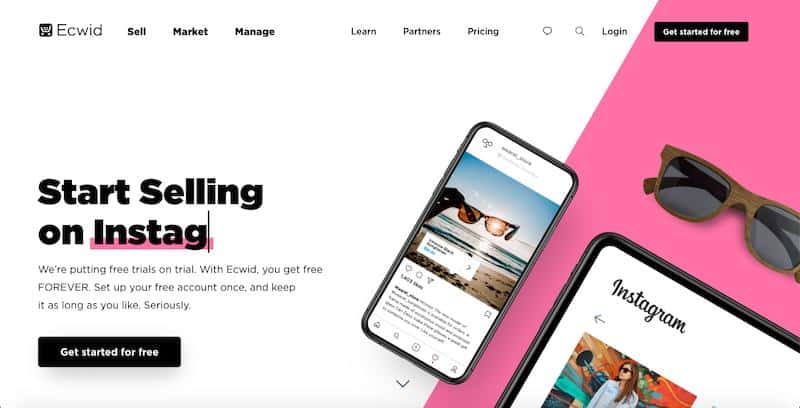
With a customer base of 1.6 million small businesses, Ecwid is an excellent and one of the most popular ecommerce platforms available. It also got awarded the “fastest ecommerce implementation platform” by G2 Crowd.
It’s most suitable if you already have a website and want to add a new store or shopping capabilities to it. The good news is that the platform is simple and straightforward to use.
Moreover, it’s entirely flexible and enables users to sell on numerous sites like:
- Amazon
- eBay

This helps you reach out to a massive number of buyers across the world on different platforms from one dashboard.
Starting with Ecwid is also decidedly easy. And if you run your website on platforms like Joomla, Drupal, or WordPress Business, then things become even easier for you because of Ecwid’s in-built integration with them.
Furthermore, it has a highly customizable storefront, which ensures maximum visibility for your products – no matter which device the customer is using. You can prominently display brand elements like logos, colors, and messages to attract your target audience.
Ecwid also allows you to create, manage, and track all of your advertisements right from the dashboard itself. Curating the perfect Facebook advertisements or Google advertisements is also easy.
The payment process is straightforward, courtesy of Ecwid’s seamless integration with over 50 payment gateways like First Data, PayPal, Square, Stripe, WePay, and more via an in-built functionality with top POS systems.
Additionally, Ecwid is a ‘PCI DSS validated Level 1 Service Provider,’ which helps it ensure end-to-end data encryption and secure customer and merchant payment details.
Some of Ecwid’s other unique capabilities are:
- Inventory tracking
- Saving favorite products
- A comprehensive customer address book
- Managing product options
- Automatic updates
- Smart shipping calculations
- An easy checkout process
All these features (among others) help Ecwid stand out from its counterparts. That said, it has its limitations as well. Firstly, it doesn’t offer services in languages other than English. They also don’t provide any telephone support.
However, the feature-rich and diverse pricing plans make up for the limitations. The good news is that Ecwid comes with a free plan that provides all the necessary functions and lets you sell ten physical items in a month.
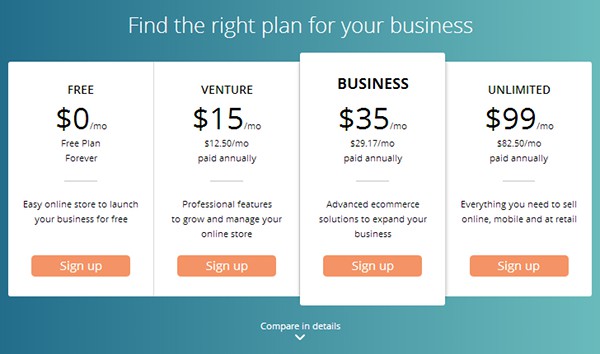
Then they offer three paid plans.
- The Venture plan lets you sell 100 physical or digital items for $12.50 per month.
- The Business plan comes at $29.17 per month allowing you to sell 2,500 items.
- The Unlimited plan ($82.50 per month) includes all sales channels.
If you already run an ecommerce website and want to migrate it to an easy-to-use-effective platform to sell across multiple channels, Ecwid could be for you.
You can try them out with a completely free plan.
7. 3dcart.
Best Ecommerce Platform for Small Business Sites ($19/month).
3dcart is one of the fastest-growing ecommerce platforms known for its robust SEO features, 50 free themes, and 100+ payment processors.
Their plans range from $19 per month for a Startup Store up to $114.50 per month for their Pro Store plan. All plans come with domain registration, no transaction fees, unlimited bandwidth, a Facebook store, a built-in blog, API
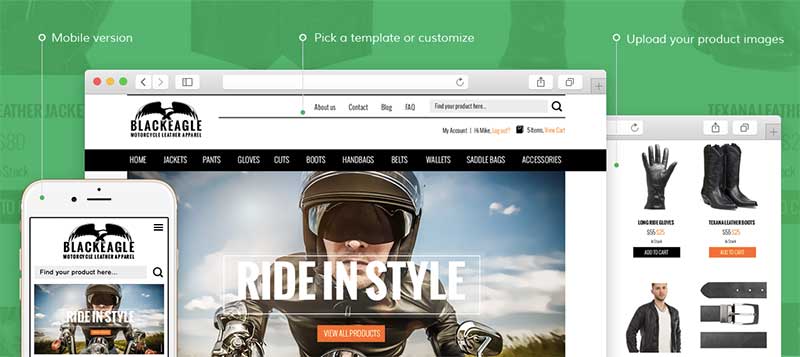
They recently released new shipping settings and an upgrade to their promotional tools. For shipping, you can display all of your order’s shipping carriers and rates on your checkout page instead of just one at a time.
Then rates are loaded automatically when a buyer checks out with their credit card or PayPal.
With their Advanced Promotion Manager, you can choose multiple Customer Groups to offer a promotion at once instead of one group like in the past. This option is excellent for B2B brands that want an online shopping cart for both consumers and retailers.
Their SEO features are strong and they are touted as “the best ecommerce platform for SEO”. You can create custom URLs, dynamic meta-tags, link titles, and more.
They also take security seriously and are 100% PCI compliant. You can also sell outside of your ecommerce platform with the 3dcart built-in Facebook store. Additionally, you can reach shoppers on the go with mCommerce for mobile devices.
Ultimately, if you’re a small business that needs strong SEO, marketing tools, and ecommerce functionality without the need for advanced enterprise features, 3dcart is a solid choice.
You can try them out with a 15-day free trial.
8. WooCommerce.
The Ecommerce Platform for WordPress (Free + Paid Add-Ons).
With over 74 million downloads, WooCommerce powers around 25% of online stores worldwide. This simple open-source ecommerce plugin for WordPress launched in 2011 and has grown into one of the most popular ecommerce solutions on the market today.
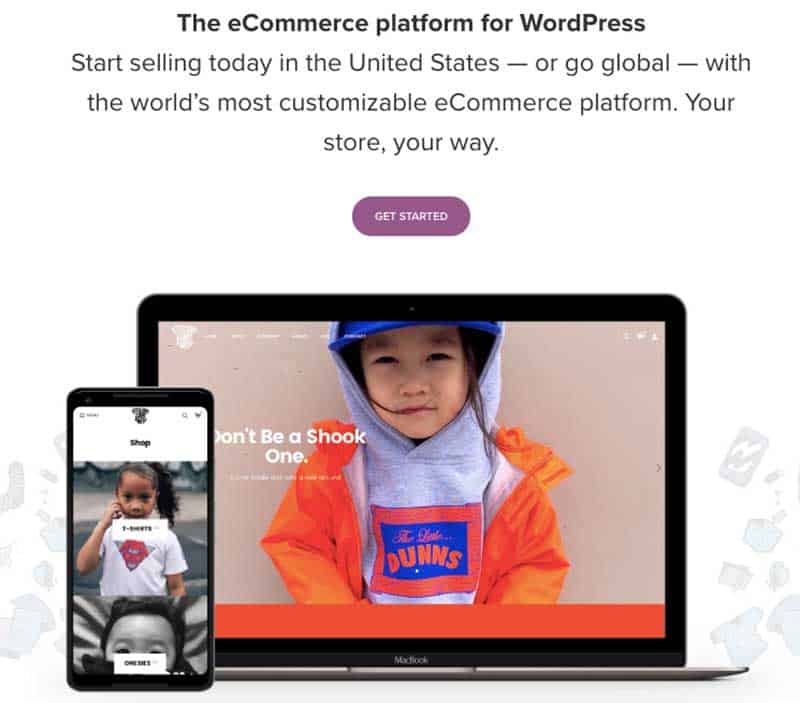
WooCommerce is a completely free plugin that you can add to your WordPress site. However, for more advanced functionality that you’ll find with other ecommerce platforms on this list, you need to add paid extensions.
Another drawback is scalability. I installed the plugin on my site and first noticed that it installed a total of four plugins to run and slowed down my site a bit.
Drawbacks aside, there are a few reasons that so many people use WooCommerce. First, it is a highly customizable solution. There is a large community of WooCommerce developers who add new functionality due to the open-source nature of the plugin.
Second, WordPress is one of the best platforms for SEO on the market. With endless SEO customizations and the ability to have more control over your search results, WooCommerce is a natural extension of the WordPress platform.
However, it’s not the only option, as I currently sell digital products on my WordPress site with the BigCommerce for WordPress plugin. I found it much faster as it’s a “headless commerce” solution that works via an API.
Overall, if you have a WordPress site and want to add ecommerce functionality for free, give WooCommerce a try.
What Are Ecommerce Platforms?
Ecommerce platforms are software tools to help people sell products and services online. Historically, businesses had to purchase expensive, on-premise ecommerce software with an IT setup and in-house hosting to manage their ecommerce. Now, with SaaS software technology, users can build storefronts (front-facing sales channels) online.
These ecommerce platforms handle everything from web design and product listings to shipping, taxes, and marketing. Within these web-based software tools, you can add your own products, manage inventory and orders, communicate with customers, sync with other apps, and more.
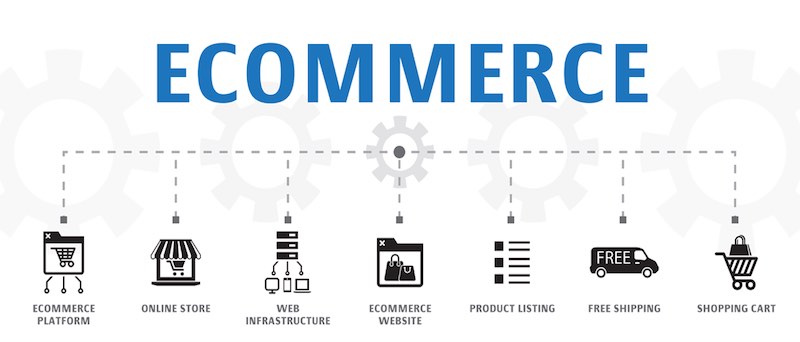
What is the Best Ecommerce Platform for SEO?
When it comes to ecommerce SEO, there are a lot of important ranking factors, including site speed, URL structure, page titles/content, and sitewide HTTPS.
1. Wix.
Most online store owners struggle with SEO and rely on paid Facebook and Google ads to generate interest in their products.
Wix has a free SEO tool called Wix SEO Wiz. Wiz analyzes your ecommerce site and automatically provides a personalized SEO plan with a checklist to improve your Google rankings.
This includes optimizing your SEO titles and meta descriptions, adding alt text, and indexing tools to get your pages ranking faster. Wix and Google collaborated on this feature and Wix users can see their pages in search results immediately after using this tool.
2. BigCommerce.
My second pick for the best SEO is BigCommerce. Here’s why:
With site speed, you want to make sure your ecommerce host loads your site content quickly on mobile and desktop. Even a 100-millisecond delay in load time can drop your conversion rate by 7%.
Use tools like GTMetrix and Google PageSpeed Insights to check your ecommerce site speed regularly.
Second, image compression is another critical factor in site speed. Images that take a long time to load increase page load times, which impacts user experience and SEO.
BigCommerce is the only ecommerce platform to give merchants Google AMP on both product and category pages, as well as automatic image compression with Akamai Image Manager.
Regarding the URL structure, BigCommerce features the best default URL format.
For example, as highlighted earlier, www.rebelpeak.com/camping/blue-tent is the best format to follow in the order of domain, category, and product. They allow you to do this, while other platforms like Shopify force you to keep their structure, including the static “/collections/,”/pages/,” and “/products/.”
This URL structure is not ideal for SEO, so BigCommerce wins in this regard and is a great pick.
What Are the Best Free Ecommerce Platforms?
If you’re looking for a free or open-source ecommerce platform, you can find many readily available. When researching different ecommerce frameworks to use, it’s essential to ask yourself a few different questions:
- Are you interested in self-hosting?
- How much web development experience do you have?
- How much creative control do you want?
- Would you rather pay a small fee every month to have everything wrapped up in one package?
I would personally go with a paid option over an open-source system because the small fee will save you a ton of time and development costs.
Open source platforms have some limitations. What you gain in flexibility, you lose in simple hosting, maintenance and security, and dedicated support.
What Are the Best Ecommerce Platforms for Small Business?
Small businesses running online need uptime guarantees, security, PCI compliance, usability, and performance. If your business depends on ecommerce sales, your requirements will be more stringent than one individual selling online.
When it comes to B2B ecommerce platforms, there are also a lot of dependencies on your platform’s user access levels, shipping methods, tax calculations, and invoicing software. You need a solution that is easily managed by multiple users and minimizes time to complete orders.
After all, the more time you save on compliance, shipping, and fulfillment, the more time you have to market your business online.
Here are my top picks for the best ecommerce platforms for small business:
1. Wix.
Wix is best for businesses selling online because of their nice-looking templates and easy-to-use software. You can manage everything from one simple dashboard so it’s best for non-tech savvy users.
2. 3dcart.
3dcart is a great choice for small businesses because of their ease of use and SEO features. Local small businesses will benefit from their clean URL structure and easy access to selling products online. Plus, they have an excellent support team available via chat, phone, and email.
3. Shopify.
Shopify is another good ecommerce platform for small businesses for similar reasons. They are super intuitive and easy to use – almost any small business owner should be able to build and manage a site on Shopify. With automatic shipping and tax rates, they save business owners time.
Additionally, if you need to learn how to use POS systems, Shopify is a great choice. They integrate with many top point-of-sale systems for omnichannel retailers with both physical storefronts and online stores.
What Are the Best Ecommerce Platforms for Dropshipping?
Dropshipping software must easily integrate with wholesalers, connect your inventory across platforms, and automate shipping.
When you hook up your online store to a wholesale supplier, the first thing you need to check is that inventory levels automatically sync between platforms. The last thing you want to happen is someone orders a product on your site that’s out of stock with your wholesaler.
Here are my choices for the best platforms for dropshipping:
- Wix
- Shopify
- BigCommerce
What Are The Benefits of Using an Ecommerce Platform?
‘If your business is not online, your business will run out of business.’
This statement by Bill Gates turned out to be prophetic — the ecommerce market is now massive and continues to expand with time.
According to a recent study, over 50% of Americans prefer to shop online. Ecommerce isn’t going anywhere and you can get a slice of that profit with a simple website.
However, you need an attractive and engaging website if you’re looking to gain customers.
So let’s look at all the benefits of building your ecommerce store, and how it can successfully drive your business.
1. Easy Scalability.
When you run a traditional brick and mortar retail shop, it’s difficult to cater to an audience that is geographically very far away.
Unless you become very successful, and operate like Walmart and other industry leaders, setting up multiple outlets in different areas become too expensive.
Naturally, it’s not very easy to do that for a small or medium-scale retailer, since it is exceptionally cost-intensive.
However, using ecommerce platforms, small and medium businesses can now target and reach out to a global audience, and scale up to many times their original size.
Most platforms let you set up your online store for between $15 and $50 per month, with the most common price being around $30.
Being online essentially makes the whole world your oyster, and you don’t need to target a particular neighborhood and restrict yourself to a specific area. With a broader reach, your sales will get a boost, and profitability will increase in the long run.
Ecommerce platforms help you achieve scalability by delivering fast-performance and impressive shopping experiences anywhere.
2. Excellent Customer Support.
Customer experience plays a big part in the annual revenue of any business. In fact, it is one of the most indicative yardsticks of a competitive company.
Even if you’re using a pre-designed template to build your website, you might run into an issue every now and then.
It can be anything — you might struggle with slow website speed or face errors with a webpage.
However, every single ecommerce platform offers customer support to help you with these issues.
For example, Bigcommerce provides 24/7 chat, email, and US-based phone support for technical issues.

They also have a premium services team, devoted to making your business excel and help you solve any technical issue to might face. And this can make all the difference.
With this type of support and flexibility, your business won’t slow down because of technical issues.
3. Social Media Integration.
More than 3 billion people in the world use social media – a huge market to tap into.
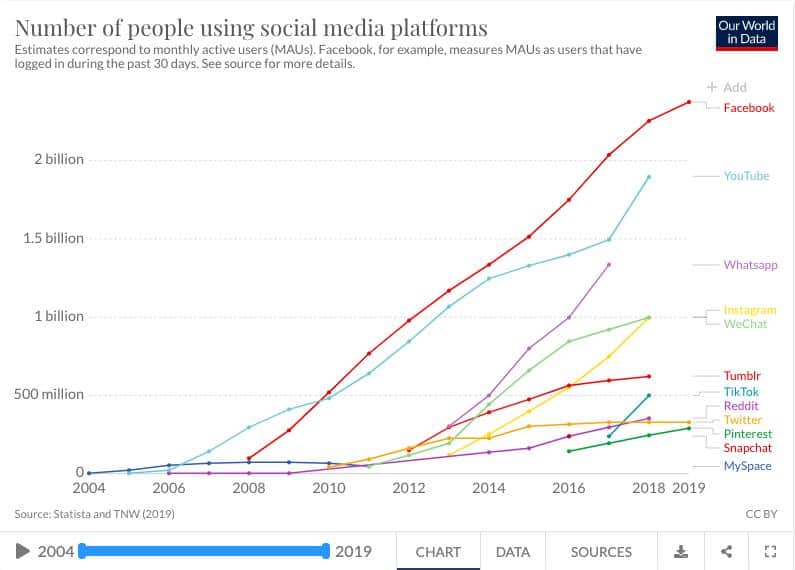
Plus, shopping behaviors are changing and more users are ready to purchase products via social media.
Ecommerce platforms easily integrate with Facebook, Instagram, and Pinterest so that you can sell your products wherever your audience is.
Therefore, it’s essential to focus some attention on social media engagement.
For example, let’s take a look at Bigcommerce.
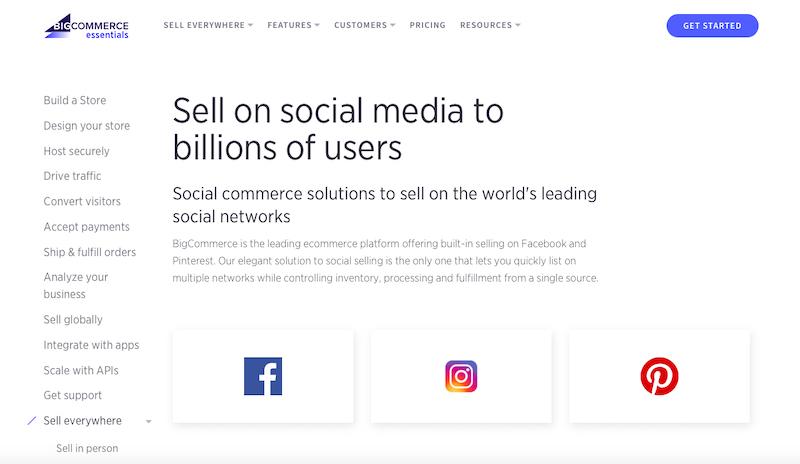
Their platform integrates with social media platforms like Facebook, Instagram, and Pinterest right from the BigCommerce control panel, syncing your inventory for you, and making the backend sales with little work required.
4. Built-In Ecommerce Marketing Tools.
Social media integration will lead you to where your target audience is, but it isn’t the only marketing you should do.
After your website is up and running, you need to identify what your customers want to buy with the right marketing tools.
Ecommerce platforms help you do that by providing numerous in-built marketing tools. These tools provide you with all the essential data and analytics to help you draw a roadmap for future sales.
Take Squarespace, for instance:
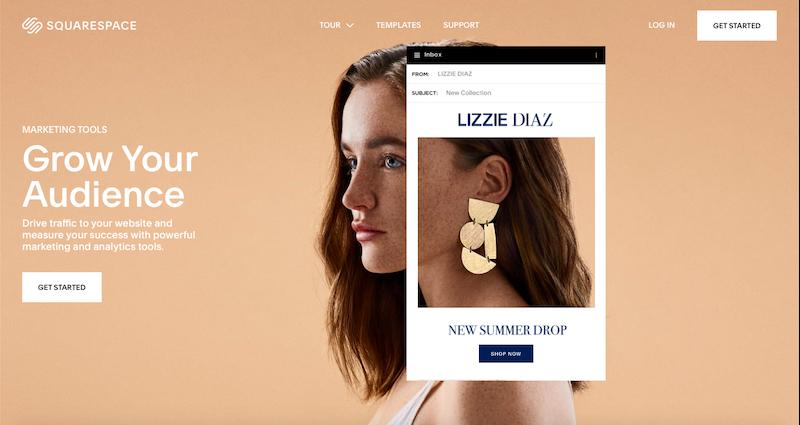
It helps drive traffic to your website with its powerful marketing tools and also measures your success quantitatively with its advanced data analytics tools.
Built-in newsletters, exit-intent pop-ups, coupon codes, and promotions are just a few of the marketing features at your disposal.
5. SEO.
Pretty much every ecommerce platform provides basic to advanced SEO features. These features enhance your search engine visibility and manage everything from sitemaps to meta titles, descriptions, keywords, and more.
If you’re used to running sites on WordPress, you can try out WooCommerce for solid SEO results.
For example, WooCommerce is integrated with some of the best SEO-related WordPress plugins that you can help you optimize your website and make it appear higher in the search engines.
Some of the SEO tools include:
- Yoast SEO
- MonsterInsights
- All in one SEO pack
- Google XML Sitemaps
- W3 Total Cache
- BZ Lazy Load
- SEO Optimized Images
- WordPress SEO
Additionally, platforms like BigCommerce and 3dcart provide great SEO support out of the box.
Tips And Strategies For Using Ecommerce Platforms.
With the numerous advantages ecommerce offers over traditional retail, it’s a great avenue not just for buyers to save money, but also for sellers to maximize outreach at a minimal cost.
During the Black Friday online sales in 2017, US shoppers alone spent $5 billion.
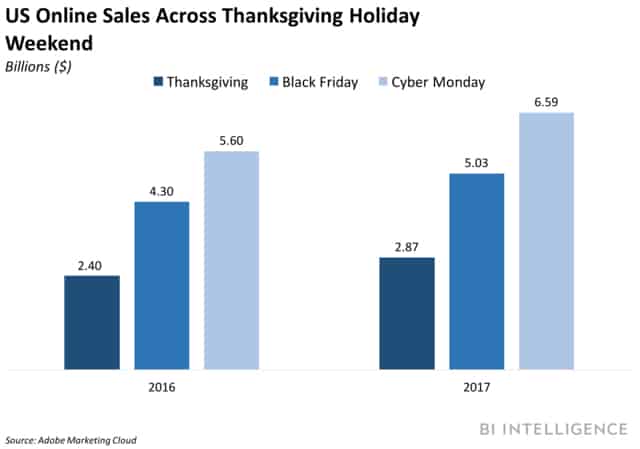
96% of all Americans have made an online purchase at least once in their life.
However, with more intense competition, it’s challenging to stand out in a crowded market.
Merely using excellent software isn’t enough. You need to have a proper full-funnel ecommerce marketing strategy in place from day one.
Here are some tips and tricks to help your marketing strategy this year.
1. Focus On Mobile Users.
We all know that mobile phones are now more popular than personal computers.
In fact, in July 2019, Google announced that the mobile-first index was a new ranking factor and here to stay.
This means that Google predominantly looks up to the mobile version of your site for ranking and indexing.
Statistics show that over 63% of online users used mobile to browse online vs. desktop.
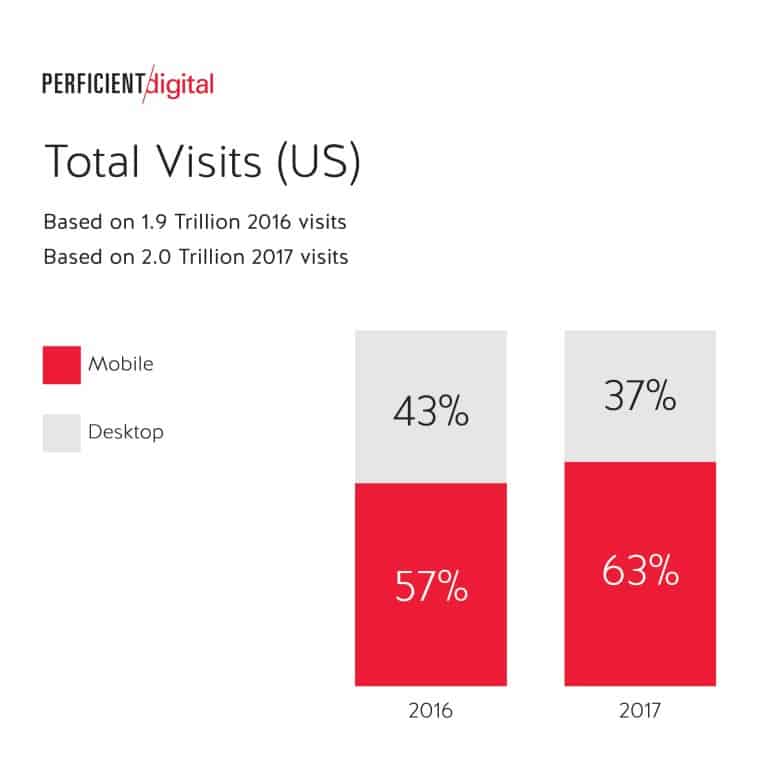
Naturally, focusing on your mobile site is now imperative.
Thus, make sure you’re using your ecommerce platform to optimize your mobile website along with your desktop site.
Shopify is one of the industry leaders when it comes to mobile optimization and theme design.
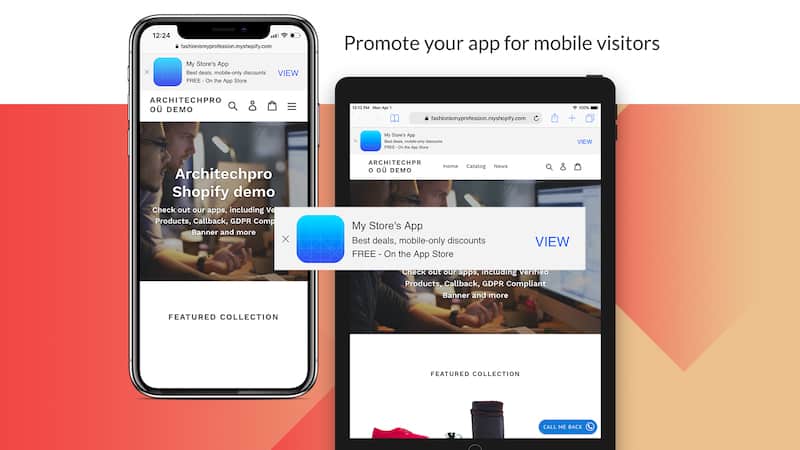
Many other ecommerce platforms provide similar benefits that can help you provide better mobile browsing experience to your audience. First, make sure your software provides a mobile-friendly homepage, category pages, and product pages.
Also, optimizing your mobile checkout experience and ensuring that your buying process is user-friendly is paramount.
2. Make Your Ecommerce Website Visually Appealing.
Studies suggest that it takes a user 0.05 seconds to decide whether they like your website or not. If they don’t find it visually appealing or understand what it’s about, they’re likely to exit right away.
Therefore, you have a shockingly small time frame to pique the visitor’s interest.
You have to make sure that you choose a website theme that is not only relevant to your niche but also appealing to look at.
On top of that, it’s important to pick a logo and imagery to give your visitors an idea about your brand right from the moment they enter your site.
The idea is to be as inventive as possible while offering a smooth browsing experience to your visitors.
Have a look at this website:
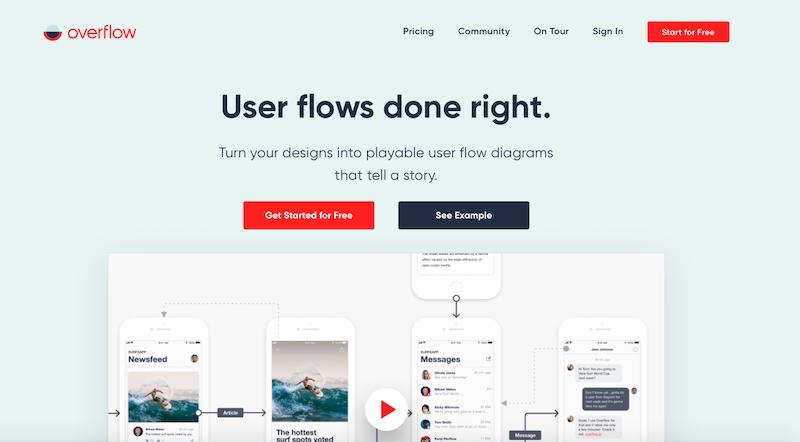
It is an excellent example of a visually appealing page, one that will make you want to scroll down. It is also easy to navigate and has relevant call-to-actions that are placed appropriately to draw the audience’s attention.
3. Provide Ease of Navigation.
It’s essential that your ecommerce site is well-structured and easy to navigate.
To make things easier for your website visitors, you can add numerous plugins with the help of the ecommerce platform you’re using.
For instance, WooCommerce allows you to automatically add a plugin that can let your users go back to the items they recently viewed.
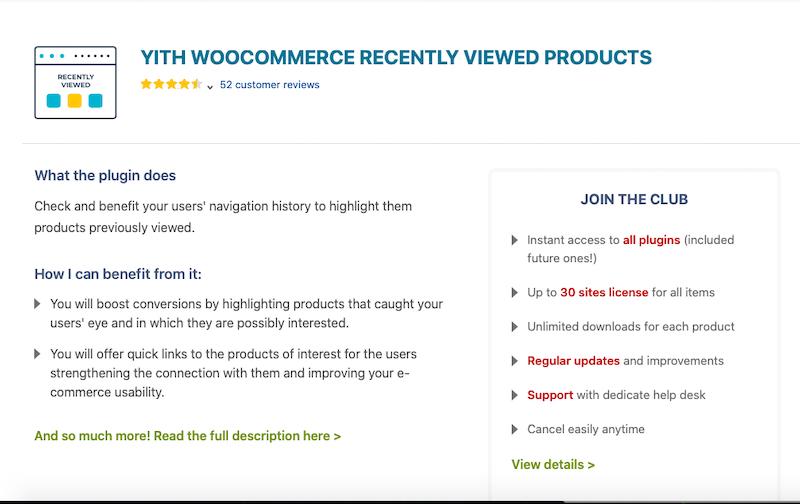
When you integrate your website with these tools that make navigation more comfortable, you provide a positive user experience and are more likely to generate sales.
Additionally, leveraging product navigation with recently viewed and suggested products can increase ecommerce conversion rates.
4. Data and Analytics.
The voices that say, ‘Data is the new oil’ are now growing louder.
Currently, there are around 18 zettabytes of data in the world. There’s no reason why you shouldn’t tap into this area.
Your strategy to boost your business using the ecommerce platform should include a plan on how to make use of your visitor information that your website generates every day.
Most ecommerce platforms come with an in-built analytics tool that can help you track your demographics.
Take Wix, for example:
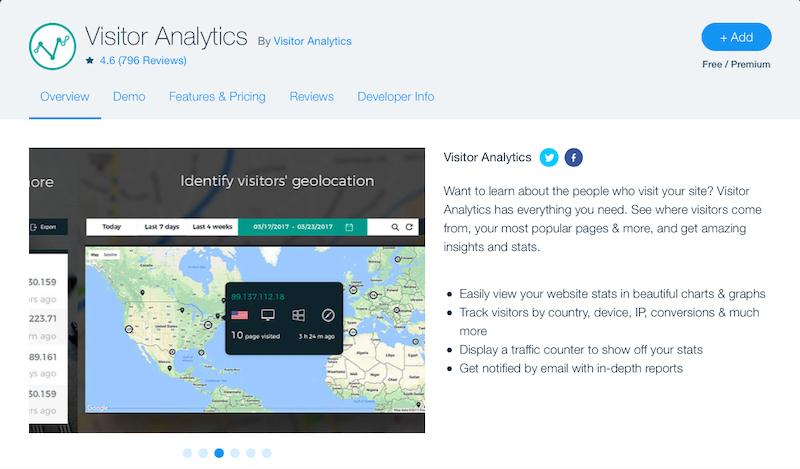
Wix provides you with an in-built visitor data analytics tool, Visitor Analytics, that can help you track the number of visitors, frequency of visitors, visualize the data generated, track by country and IP address, generate conversion statistics, and take better, well-informed decisions regarding the future.
This helps you streamline the marketing process and focus on an effective plan of action.
A majority of ecommerce platforms offer analytics tools, and it is something that you should take advantage of.
5. Provide Stellar Customer Service And Live-Chat Options.
In 2017, 64% of Americans contacted some form of customer service.
According to Zendesk, excellent customer service is the primary defining factor a customer looks at while doing business.
Furthermore, according to the Kano model here, a website that has features like live chat options and efficient customer service are delighters, and it can improve your business, boost revenue, and significantly drive up customer satisfaction.
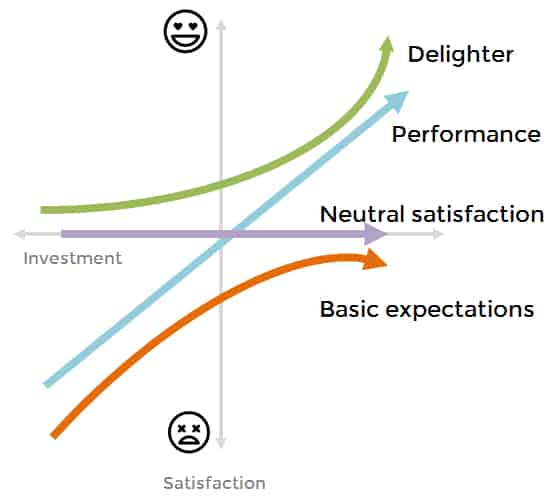
Part of your ecommerce strategy should include the integration of an efficient live chat and customer service system – preferably 24/7.
Let’s take the example of Squarespace.
It provides an excellent and easy way to add Pure Chat, a live chat software, in just a few simple steps.

With the live chat option, you can:
- Provide instant answers to your website visitors’ questions
- Engage leads and prospective customers
- Improve your conversion rates and sales
6. Omnichannel Strategy.
More and more businesses are increasingly taking the omnichannel route to sell their products.
And a good ecommerce platform can seamlessly enable a perfect omnichannel strategy. It can help the online and offline counterparts of business work in tandem towards the specific goal of selling.
For example, Magento provides a ‘Magento Order Management’ system that helps businesses achieve precisely this.
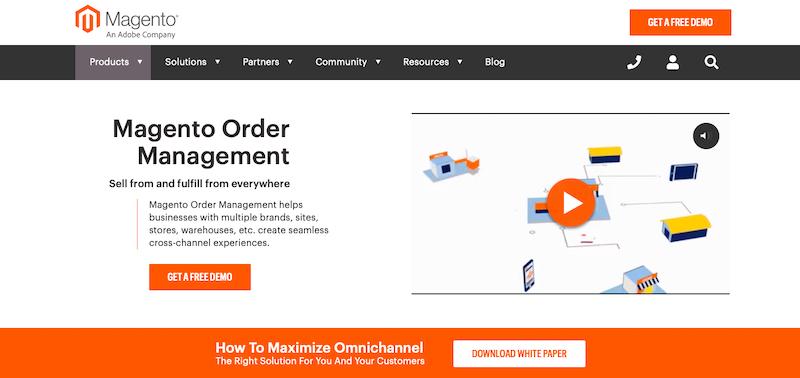
Choosing the right ecommerce platform can go a long way in ensuring whether you manage to reach your omnichannel sales goals.
In the end, it’s vital to outline each individual sales channel and your goals for each.
Ecommerce Platforms FAQ.
Is ecommerce easy?
Ecommerce is easy to get started in but challenging to be highly successful in. You don’t need much money to get started – you just need a website and a list of products. You can even use dropshipping suppliers to outsource your inventory and shipping process.
However, it can be difficult to be very successful as marketing your ecommerce brand is one of the most important factors. In addition to posting your inventory online and handling customer service, you need to focus on SEO, PPC, social media marketing, email marketing, and other tactics to generate sales.
What is the easiest ecommerce platform?
Ecommerce website builders are intuitive and allow you to easily build a website, add products, and market your business online. However, some are easier to use than others. Here are the easiest ecommerce platforms based on usability and simplicity:
1. Shopify.
2. Wix.
3. BigCommerce.
Can I sell on Facebook without a website?
Yes, without a website you can sell products online using Facebook Marketplace. If you want to sell products on Facebook, you need a Facebook Page and products to promote. On your Facebook page, you can add product information, including product names, descriptions, prices, photos, and more.
What ecommerce platform does Amazon use?
Amazon sites use the AWS platform which Amazon created. They make a large income from allowing others to use their AWS service. Other big companies and websites also use AWS, including Netflix.
Is it better to sell on Amazon or Shopify?
Although Amazon is easy-to-use for small online sellers, Shopify is a better option. Shopify’s lower-priced plans are more affordable than Amazon’s Professional Plan and is a more scalable solution. It is important to build a brand presence online and that is best done by owning your own website.
Is Shopify easier than WordPress?
Shopify’s website builder is easier to set up and use than WordPress, where you face a steeper learning curve. Shopify has a lot of built-in ecommerce features that are not included in WordPress without plugins. However, WordPress different benefits like better SEO, more customization options, improved blogging, and more. In the end, it’s up to what you’re most comfortable with.
How can I sell online for free?
If you don’t have the budget to use an ecommerce platform, there are certain ways to sell online for free. Some of these include:
1. Craigslist.
2. Facebook Marketplace.
3. LetGo.
4. Geebo.
5. eBid.
Executive Summary.
There you have it – my list of the best ecommerce platforms.
- If you’d like to use the best overall platform that is easiest to use and best for small business, go with Wix.
- If you want the best software to scale your large business, I recommend you get started with BigCommerce.
- If you’re a dropshipper than needs the good integrations, Shopify is your best choice.
What popular ecommerce platforms do you recommend?










![Conversion.ai Software Review [This Is RIDICULOUS!]](https://topguide4you.com/wp-content/uploads/2021/05/Conversion.ai-Software-Review-1-100x70.png)

